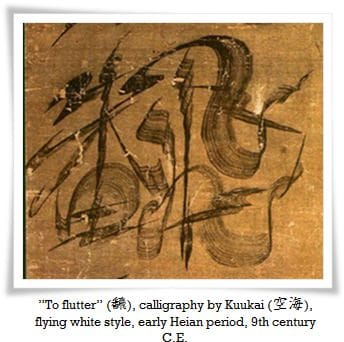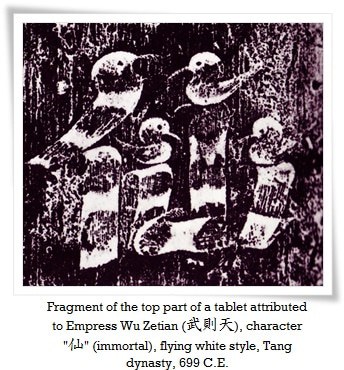Flying White (飛白, kasuri) is not classified as one of the major styles, and there are a few reasons for this. First, it ought to be written with a flat painting brush (although it is not imperative), and second, it can depict any of the five major styles in sho.
There are many odd creations out there, such as “fly’s head style” which is so small that its creator, Weng Fanggang (翁方綱, 1733 – 1818), was able to fit a seven word long poem on a sesame seed! Flying white is one of those extraordinary approaches to calligraphy, and will be utilized as a representative here.
Kasuri is extremely beautiful. Light, poetic in its mobility, graceful, and delicate. It is quite often combined with paintings interwoven into the text, such as dragons, birds, or other motifs.
Flying white owes its name to a special brush technique applied during writing that leaves behind ribbon-like wide lines, giving an impression of jumping or leaping on the paper surface without losing contact with it, all executed in one stroke. Smudgy lines of the strokes reveal white streaks called kasure (掠れ). As mentioned above, since flying white is more of an aesthetic brush technique than a style per se, it could be used virtually with any of the calligraphy scripts (though usually we can see it applied in standard or semi-cursive styles).
Its creation is attributed to the famous calligrapher Cai Yong (蔡邕, 132 – 192) of the late Han dynasty (後漢, 29 B.C. – 219 C.E.), who was an incredibly creative artist. One day he observed a painter using flat painting brushes to renovate a sign mounted on a gate and was intrigued by the characteristic patterns formed by the drying paint. He immediately tried to apply the technique to calligraphy and was quite pleased with the effect.
Today, flying white is not an often used technique. Nonetheless in history it had few great admirers worth mentioning. One of them was emperor Tang Taizong (唐太宗, 599 – 649) of the Tang dynasty (唐朝, 618 – 907). He was a very enlightened ruler, open to criticism and the benefits of the improvement that come with it. It is said that Emperor Taizong’s flying white was exquisite.
Empress Wu Zetian (武則天, 624 – 705), the only empress in Chinese history, also referred to as Tian Hou (天后, Empress of Heaven), a former concubine of emperor Taizong, managed to develop her own style of flying white decorated with bird drawings. Her sho was like her character; strong, expressive and bold.
Flying white also migrated abroad, together with other Chinese styles. In Japan, Kuukai (空海, 774–835), the Buddhist monk, scholar and poet, also possibly the greatest Japanese calligrapher of all time, brilliantly merged flying white with gyousho (行書, semi-cursive script) in his work titled Juunyoze (十如是, lit. “ten as they are”). Unfortunately the original of this masterpiece was destroyed by fire.


